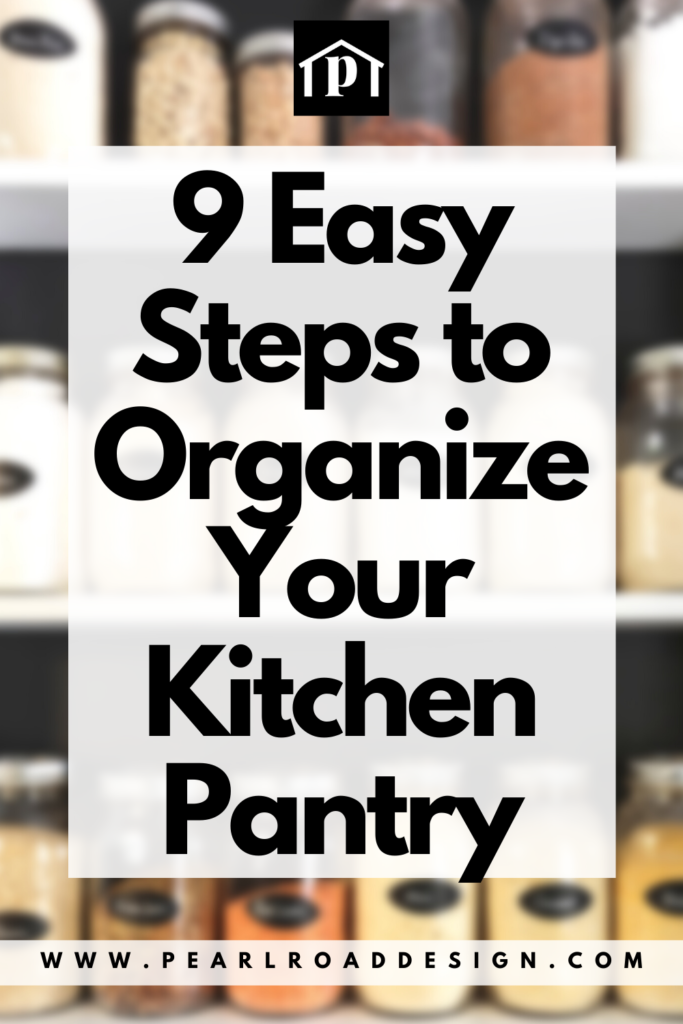
Organize your pantry once and for all
A functional and organized pantry goes a long way in the kitchen when done right. But when it comes time for you to organize your pantry, the thought alone is enough to make you want to give up before you even get started.
It’s no simple task, that’s for sure. But, it doesn’t need to be as overwhelming as it sounds. Let’s break down 9 simple steps to organizing your kitchen pantry, for a clutter free and beautiful space.
Step 1: Empty out your pantry
Start by removing all items from your pantry and emptying it out.
While you’re at it, if you have random food items hiding out in cabinets that you’d ideally want to store in your pantry, take them out as well. (For example, those 3 cans of soup in the cupboard that have literally nowhere to go in your current pantry setup).
Step 2: Group similar items
By now, you should have a pile of non-perished goods, various food items, and random fruit snacks sprawled across your counter.
Begin grouping similar items together based on a category. For example, if you’ve got bags of Penne and Spaghetti, start creating a pasta pile. If you’ve got canned soda and bottles of water, start creating a drinks category.
Step 3: Get rid of expired food
Next, you’ll want to toss out any old and expired food that’s been lurking away in your kitchen pantry.
The key to organize your pantry is a clutter free space, so take this step seriously. Get rid of any excess items that are well past their shelf life.
Step 4: Get containers to organize your pantry
Now that you have all your pantry must haves ready to go, you’ll want to invest in some storage options to help keep things organized.
Containers and jars work well for any loose items that are currently in a bag or box. Things like flour, rice, pasta, sugar go great in jars and preserve longer with a seal.
Packaged items like snacks or granola bars can be organized in baskets or large bowls.
Tips to remember when choosing storage for your pantry:
- Make sure you are getting storage containers that are the same shape. Different sizes can work, but you’ll want to choose jars that are the same shape and brand so the overall make is uniform. This will allow things to fit better and can help when you’re stacking items.
- Look for containers that will actually fit in your pantry. If you have a small pantry you’re working with, you want to be extra cautious. Be careful in choosing jars that may be too wide or too high to fit the space.
- Get a few extra containers as overstock for future purchases. You’ll want to repeat this process for every new item coming in (which we’ll get into in step 9!)
Step 5: Label your containers
Equally important, is taking the time to label your containers.
It’s easy to mix up foods that have a similar look and texture. Save yourself time from sniffing out what the food could be, to just simply labelling each jar or basket accordingly.
Pro tip: be sure to write down the expiration date of the product as well. You can label this on the bottom of each jar to keep it hidden,
Step 6: Determine your pantry layout
Now, it’s time for the creative part!
A crucial (and probably the most difficult) step of pantry organization is figuring out how all of these items are now going to fit back into your pantry.
When deciding your layout, there are a few things you need to consider:
- The space has to be functional, otherwise it’ll be a matter of hours before everything gets disorganzed again
- Don’t jam pack your pantry. You need room to grow. Leave ample room between things and keep the space spacious. If that doesn’t work, you just may need to purge a few more items.
- Decide your layout according to your lifestyle and habits. You may want to put all the carbs near each other, or you may want to make sure all pasta sauces and pasta jars are close to one another. Do this based on your personal preferences and usual method of grabbing things out of your pantry.
As you start to think about this and play with the space, you want to make sure you’re not covering items as part of your plan. If your pantry has deep shelves, you want to be extra cautious about this.
An organized pantry means you can quickly see and access all of your items at any point. Stuffing things far in the back isn’t functional, and it won’t be long before you’re buying duplicate items without realizing that you already had what you needed at the back of the shelf in the first place.
Items to invest in that will help organize your pantry with deep shelves include:
- A lazy susan or turntable
- Tiered shelving
- Acrylic drawers
Step 7: Arrange your kitchen pantry
Next, comes the fun! Time to put your plan to action.
Start putting all of your newly decanted items into the pantry based on the blueprint you created.
A word of caution: you may need to shift things around a few times if your layout in step 6 isn’t quite working. Keep tweaking until you find the perfect arrangement.
Step 8: Maintain your newly organized pantry
A well organized pantry shouldn’t be hard to maintain if it’s done right. Follow this process every time you purchase something at the grocery store that doesn’t have a spot. Use one of the extra containers you purchased in step 4, group the item with its family and find it a home!
Organize your pantry = organize your life. Enough said.
Read more: 5 Clever Tips to Organize Your Spices

